Semiconductor Relay (Solid State Relay in English) is an extremely important device in industrial and civil electronic circuit boards. It plays an important role in controlling and isolating electrical signals in electronics and automation applications,...
So what really is a semiconductor relay? What is the structure and working principle? Please read the article below for the most general overview.
1. What is a Semiconductor Relay (SSR)?
SSR stands for Solid State Relay, which is a type of solid state relay commonly used today. This is a type of switching relay that does not require the use of any mechanical parts, providing many advantages in terms of longevity compared to conventional electrical relays. SSR has its own regulatory design compared to electromechanical relays, so the intensity is somewhat faster.
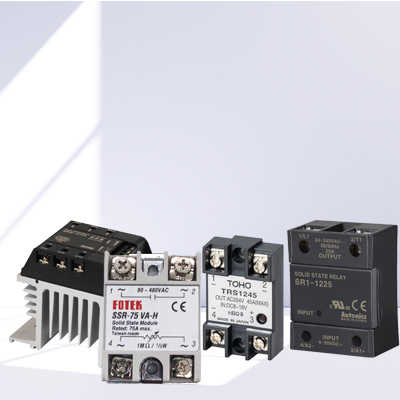
Actual image of semiconductor relay
2. Structure of semiconductor relay
- Semiconductor relays have the difference that they have moving parts and when operating, they will emit sound due to mechanical contacts opening and closing under the force of a magnetic field.
- Semiconductor relays have a fairly simple structure including 1 coupling and one or more MOSFETs
- Coupling: has the function of isolating small control current from large load current. The most common is optical coupling. When a small current flows through, the LED will emit light, the diode receives the light and activates the current through the MOSFETs adjacent to it, allowing load current to flow through the circuit.
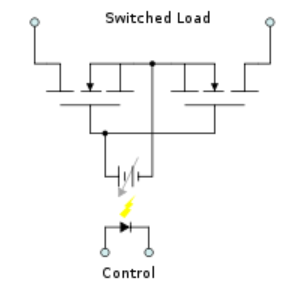
Structure of semiconductor relay
3. Operating principle of semiconductor relay
- Semiconductor relays have many different types, but they all have the same structure and operating principle, which is to use a small resistor (small resistors can be variable resistors, 4-20mA 0-10v analog signal , relay signal from the controller...) to control a much larger load current
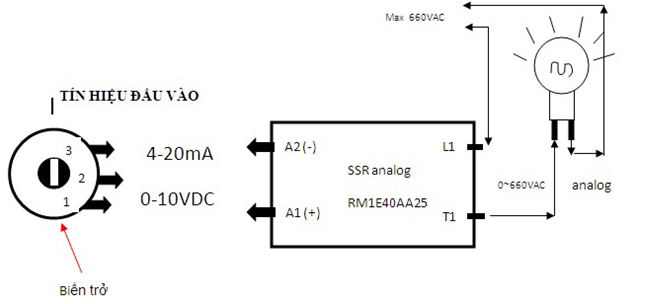
4. Types of semiconductor relays
- There are two main types of semiconductor relays (SSRs): 1-phase semiconductor relays and 3-phase semiconductor relays, corresponding to the number of phases of the power supply used:
+ 1-phase semiconductor relay: 1-phase semiconductor relay is used to control 1-phase electrical load, including a control input and a load output. Single-phase semiconductor relays are often used in simple applications such as lighting, small motor control and simple temperature control applications.
+ 3-phase semiconductor relay: 3-phase semiconductor relay is used to control 3-phase electrical loads, including 3 control inputs and 3 load outputs. 3-phase semiconductor relays are commonly used in industrial applications such as electric motors, control and measurement systems, and complex temperature control applications.
- In addition, semiconductor relays can also be classified based on the type of control, including DC or AC control, as well as based on the type of load being controlled, including reactive loads, alternating current loads. (AC), direct current (DC) and alternating current (AC) motor loads.
Semiconductor relay 1 phase - 220V

To use a single-phase semiconductor relay (SSR), you need to perform the following steps:
- Check connection requirements: ensure that the voltage and current of the load match the parameters of the semiconductor relay.
- Input connection: 1-phase semiconductor relay has two inputs, one positive (+) and one negative (-). Control the semiconductor relay through this input by applying voltage to the positive (+) or negative (-) input.
- Output connection: 1-phase semiconductor relay has two outputs, one positive output and one positive output and one negative output.
- Connect your load to this output.
- Check connections: check your connections again to ensure that all inputs and outputs are connected correctly.
- Semiconductor relay configuration: normally, you need to configure the semiconductor relay before use. Configuration instructions can be found in the manufacturer's documentation.
- Using semiconductor relays: After configuration is complete, you can use semiconductor relays to control electrical loads remotely.
3 phase semiconductor relay
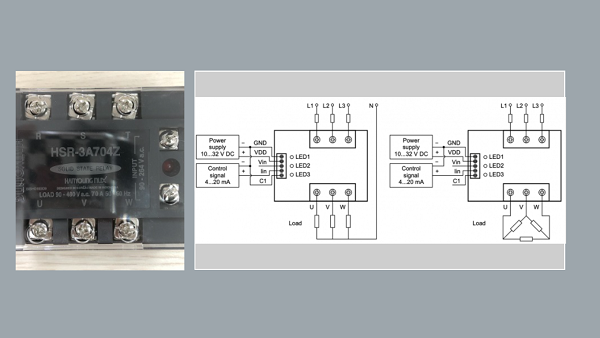
-
- To use a 3-phase semiconductor relay, you need to connect three AC voltage inputs to pins L1, L2 and L3 of the relay. You can then connect your electromagnetic devices to the output pins of the semiconductor relay.
- For control signals, usually use 4-20mA or 0-10V to connect to the corresponding Signal (+) and (-) pins to receive signals from the controller.
- When the relay is activated by a control signal, it opens or closes the circuit depending on the connected electromagnetic devices. 3-phase semiconductor relays are commonly used to control 3-phase motors, lights, air compressors and other electromagnetic devices in industrial applications.
5. Important parameters of semiconductor relay
- Control current: SSR uses infrared LEDs so the input current needs to be paid attention to. If the current is too large, the LED in the relay will die, causing the relay to die, and if the current is too small, it will not work.
- Output load current: depending on the type of SSR semiconductor relay, there will be certain parameters. This must be followed because if the wrong current is connected, it will kill the relay
- Voltage difference at the output: The SSR semiconductor relay will be destroyed if you connect a small voltage difference to loads with a large voltage difference.
- Excitation voltage, load switching voltage
- Load line
- Input current
- Output voltage
- Output current: 40A
6. Advantages and disadvantages of semiconductor relays
Advantage:
- Compact design, easy to install in electrical cabinets in narrow locations
- High durability and longevity
- The ability to continuously turn on and off the relay, high stability
- When switching on and off, there is no sound or spark
- Diverse input signals
Defect:
- Need good heat dissipation for semiconductor relays when working with large loads
- Diverse input signals
- Technical requirements must have knowledge of the product before installation
- Electrical leakage and short circuit may occur
7. Application of Semiconductor Relay
- With a special design, SSR semiconductor relays are only widely used in industry. Therefore, it is difficult for us to encounter SSR in everyday civil applications. Besides, semiconductor relays are often used:
+ For single-phase semiconductor relays: lighting, small motor control and simple temperature control applications,...
+ For 3-phase semiconductor relays: used in industrial applications such as electric motors, measurement and control systems, complex temperature control applications, water pumps, air compressors or control systems. air conditioning,...
8. The best semiconductor relay brands on the market
- There are many brands on the market that provide semiconductor relays, the most typical of which are:
+ Brands of Korean origin: Autonics, Hanyoung,...
+ Chinese and Taiwanese brand: Fotek
8.1) Autonics semiconductor relay
- Autonics has many lines of semiconductor relays such as:
+ SR1 series (Separate heatsink type SSR, single phase)
+ SRC1 series (slim type SSR with separate heatsink, single phase)
+ SRH1 series (SSR type with integrated heatsink, single phase)
+SRS1 series (Separate radiator outlet type SSR, single phase)
+ SPC1 series (Power controller, single phase)
Among them, the SRH1, SR1, SPC1 lines are the most popular.
- Featured:
+ High dielectric strength: 4000VAC
+ Supports Zero-cross Turn-on/Random Turn-on mode
+ Check input status with input indicator LED (blue)
+ Improved reliability by increasing heat conservation coefficient with ceramic circuit board
+ Increase user convenience with compact design
+ Diverse installation methods (DIN rail, fixed screws)

Reference Relay bán dẫn Autonics
8.2) Hanyoung semiconductor relay
- Among relay types, the semiconductor relay product line offers many advantages with simplification and maximum performance for automation systems. Semiconductor relays of this Korean brand are often designed with compact size and weight to save installation space, and can be moved or carried when used. Being made from high-quality, sustainable materials helps ensure maximum safety when used.

Refer to Hanyoung Semiconductor Relay: https://amazen.com.vn/relay-ban-dan/hanyoung.html
8.3) Fotek semiconductor relay
- Fotek has many lines of semiconductor relays: SSR Fotek series, LSR Fotek series, TSR Fotek series, ESR Fotek series,... Of which the SSR, LSR, TSR series are the most popular.
- Specifications
+ High dielectric strength above 4KV
+ High isolation strength over 100MΩ/500VDC
+ Has overheat protection circuit(120oC)
+ Electric current increases
+ High gain voltage supply
+ Conforms to EN60947-4-3 and EN60950
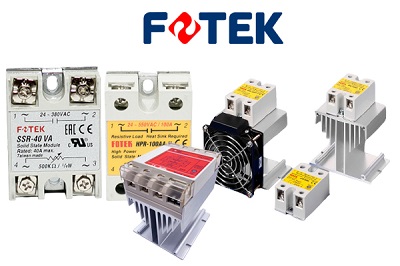
Refer to Fotek Semiconductor Relay at good prices at: https://amazen.com.vn/relay-ban-dan/fotek.html
Epilogue
Above is all the most important and basic content about the Semiconductor Relay product line. Hopefully the article content will assist you in the process of learning, choosing to buy and operate this line of automation equipment.
In case you need to buy a semiconductor relay or have any questions or need further advice, please contact Amazen via:
Hotline: 0934 399 068 - Sales: 0938 072 058
Email: amazen@amazen.com.vn
With a team of highly specialized technical support and sales consultants, our company is confident that it will bring customers the best purchasing experience.
Amazen commits that all glass relay devices we currently provide are genuine, 100% brand new, quality guaranteed and fully accompanied by CO/CQ certification documents.